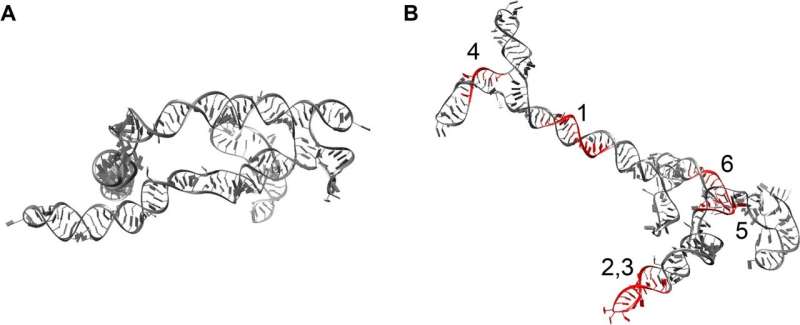This article has been reviewed according to Science X's editorial process and policies. Editors have highlighted the following attributes while ensuring the content's credibility:
fact-checked
trusted source
proofread
Fat-burning molecule may be promising target for most common childhood brain cancer

Research from Johns Hopkins Kimmel Cancer Center experts revealed a type of RNA, previously considered to be "junk," that may help doctors distinguish and treat a subgroup of patients with medulloblastoma.
Medulloblastoma is the most common malignant brain tumor in children, accounting for about 20% of all pediatric brain cancers. Four groups of medulloblastomas have been identified, and one is named sonic hedgehog (SHH) because of the spiky, hedgehog-like appearance of fruit flies missing the gene.
"We have identified a new molecule that is specific for the sonic hedgehog group of medulloblastomas. We believe that this molecule is important for early detection, and we would like to use this molecule marker as a therapeutic target," says senior study author Ranjan Perera, Ph.D., director of the Center for RNA Biology and senior scientist at the Cancer & Blood Disorders Institute at Johns Hopkins All Children's Hospital.
The findings are reported in the journal Acta Neuropathologica Communications.
The ability to better distinguish between subtypes of medulloblastomas has important implications for developing treatments and improving survival.
SHH medulloblastoma is the most common form in patients younger than 3 years old and accounts for around 30% of all medulloblastomas.
"This research identifies a new and novel target to teat medulloblastoma, a much-needed advance for this aggressive pediatric cancer," says Chetan Bettegowda, M.D., Ph.D., Jennison and Novak Families Professor of Neurosurgery.
RNA plays a part in how genes work and what they do. Noncoding RNA, which doesn't produce proteins, was called "junk RNA" for many years. Scientists are now unraveling what role noncoding RNA plays in the body.
Circular RNA (circRNA) is a type of noncoding RNA that is thought to play a role in the development of different types of cancers, making them good targets for cancer drug development. In addition, circRNAs are abundant in the brains of mammals, which makes them potential biomarkers of medulloblastoma and its subtypes.
The researchers started by merging a group of publicly available genetic data for 175 samples of medulloblastoma tissue from each of the four classification groups. These included group 3, the most aggressive; group 4, the most common; and Wnt and SHH, named for the genetic signaling pathways thought to play prominent roles in the development and progression of the cancer.
"We were trying to identify the most significantly expressed circRNAs in these four groups. We identified a couple of circRNAs that are highly enriched in sonic hedgehog and decided to go after these," says Perera, who is also an associate professor of oncology and neurosurgery at the Johns Hopkins University School of Medicine.
From this group, they found that only circ_63706 showed much higher expression in the SHH subgroup compared with the other three groups, so the researchers selected circ_63706 for additional investigation.
Next, they transplanted the brains of mice with medulloblastoma cells that were programmed not to carry out the instructions of circ_63706 and control cells to see how it impacted tumor growth. Mice without functioning circ_63706 had significantly smaller tumors than those transplanted with control cells.
Mice without functioning circ_63706 tumor cells were found to have reduced cell proliferation and significantly prolonged survival compared with the control group, demonstrating that circ_63706 regulates tumor growth and may function as a type of gene that has the potential to cause cancer.
Exploring the mechanisms circ_63706 uses to promote cancer cell growth, Perera and colleagues uncovered a link to lipid metabolism (fat burning), which is already known to be a key factor in tumor cell proliferation and growth. They found when circ_63706 is turned off, fat metabolism increases, and this action, known as lipid oxidation, is toxic to cancer, ultimately leading to cell death.
The researchers say these findings point to a potential for a targeted therapy, using a drug or drugs to block circ_63706 and cause tumor cells to die.
"We are showing in our preliminary study that when you implant circ_63706 knockout cells into mice you get reduced tumor growth," says Perera. "This supports it as a therapeutic target."
Next, this group will be studying the mechanistic role of this molecule, including but not limited to, in interacting protein partners to develop potential therapeutics.
"Although tremendous improvements have occurred in therapies and supportive care, there is more work to be done on the subclassifications and how these subgroups can be managed uniquely by improved molecular diagnostics and targeted therapies," says Stacie Stapleton, M.D., director of pediatric neuro-oncology and member of the Cancer & Blood Disorders Institute at Johns Hopkins All Children's Hospital.
"The discovery of this circular RNA in SHH medulloblastoma is promising to help with diagnostics and therapeutics to help the children we see in clinic."
More information: Keisuke Katsushima et al, The oncogenic circular RNA circ_63706 is a potential therapeutic target in sonic hedgehog-subtype childhood medulloblastomas, Acta Neuropathologica Communications (2023). DOI: 10.1186/s40478-023-01521-0


















